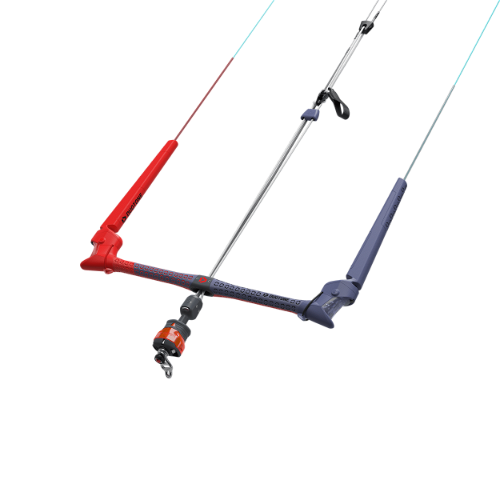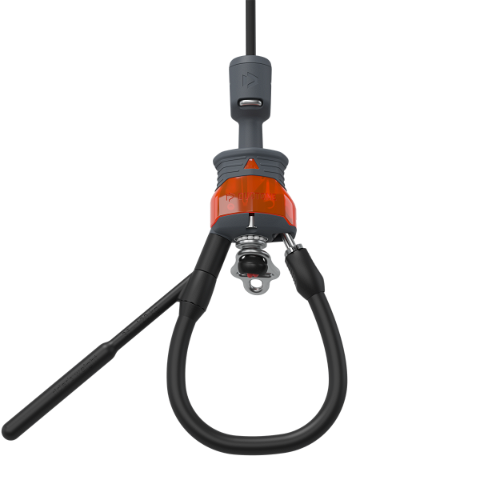DUOTONE KITEBOARDING BARS: FIND THE RIGHT BAR FOR YOU AND YOUR KITE!
HOW DO I FIND THE RIGHT BAR FOR ME?
The bar connects you to your kite, it is extremely important for the handling and performance of your kite and, above all, for your safety. Despite all this, the bar is often not given the attention it deserves. That´s why we have put together this summary of the most important terms and functionality – so you can find the right bar for you and your kiteboarding style!
:grayscale(false):quality(10):blur(20))
WHAT IS THE DIFFERENCE BETWEEN THE DUOTONE CLICK BAR AND THE DUOTONE TRUST BAR?
IRON HEART
The Duotone Click Bar is equipped with the Iron Heart 5, which automatically “swivels” the kite’s power lines. This is particularly beneficial after jumps with rotations. With the Duotone Trust Bar these lines have to be adjusted by hand while riding.
LINE LENGTHS
The Duotone Click Bar is available with a line length of 20/22 metres and 22/24 metres. This lets you adjust the length of the line as desired. The V-position can also be altered to adapt the bar perfectly for your kite. The Duotone Trust Bar is available with line lengths of 19m, 22m, 24m and 27m.
DEPOWERING
Thanks to the unique depower system on the Duotone Click Bar, you no longer need to adjust your body position when you want to power or depower your kite. This is particularly beneficial for smaller riders with shorter arms. It also removes the need for all the annoying lines required for traditional depower systems.
BAR WIDTHS
The Duotone Click Bar is available in two sizes, with a bar width of 42cm or 49cm. The Duotone Trust Bar is also available in two widths, but has a flip-flop function on the floaters for adjusting the bar width. This permits possible bar widths of 42cm/49cm and 46cm/53cm.
STOPPER
The Duotone Click Bar is equipped with a sliding stopper. Above a certain pressure, it slides upwards thus providing the very highest level of safety. The Click Bar’s stopper can also be fixed using a grub screw so that it no longer slides (not recommended). The stopper on the Duotone Trust Bar can be used as a fixed stopper, which opens up new possibilities for board-off tricks.
5TH LINE
Both the Duotone Click Bar and the Duotone Trust Bar come by default as a 4 line bar and can be extended with a 5th line.
WHICH CHICKEN LOOP DO I NEED?
DUOTONE WAKESTYLE KIT
The Duotone Wakestyle Kit comes with the largest chicken loop and a long safety leash. It has been specially developed for kiteboarders who mainly perform unhooked tricks. During unhooked tricks, you unhook the chicken loop from your harness and hold the bar in your hands in the same way as for wakeboarding – in other words, you are detached from the harness and sense the forces exerted by the bar directly in your hands. The large chicken loop lets you hook the bar back in again quickly after a trick without needing to look. The long safety leash allows tricks such as handle passes, in which the bar is passed behind your back, and its primary purpose is safety. In the event of the bar ever slipping out of your hands during an unhooked trick, you are still connected to your kite via the safety leash.
DUOTONE FREESTYLE KIT
For many years, the chicken loop on the Duotone Freestyle Kit was our standard chicken loop. It is suitable both for unhooked tricks and also for freeriders who want to perform unhooked jumps. To allow you to perform unhooked tricks, the Duotone Freestyle Kit also comes with a long safety leash.
DUOTONE FREERIDE KIT
The Duotone Freeride Kit is supplied with the smallest chicken loop and a short safety leash. It is designed for surfers who only want to perform hooked-in jumps and have no intention of performing unhooked tricks. Due to its small diameter, the Duotone Freeride Kit offers a greater depower option for the rider, which improves both safety and comfort. The short safety leash also rules out the possibility of the leash becoming entangled, e.g. between your legs.
DUOTONE ROPE HARNESS KIT
This kit has been specially developed for use in conjunction with a rope harness. Instead of the standard metal hook, a rope harness has a section of rope into which the chicken loop is hooked. This setup is primarily used for wave kites as these need to execute frequent changes of direction and turns. The rope harness prevents the harness from slipping around. The chicken loop on the Duotone Rope Harness Kit is reinforced with a metal plate to minimise any abrasion on the rope and it comes without the intrusive chicken dig.
WHAT IS THE “THREE-LEVEL SAFETY SYSTEM”?
Every well-designed bar has a three-level safety system. If one of these levels on a bar is not fully functional, this can result in a life-threatening situation for the rider and any other people involved.
1ST LEVEL – LETTING GO OF THE BAR
Letting go of the bar results in the kite’s angle of attack adjusting to a minimum. The kite should almost completely cease pulling, falling powerless into the water. (For more information on angle of attack click here.)
2ND LEVEL – QUICK RELEASE
If the quick-release system is triggered, the kite completely loses all power. Tension is lost in all except one of the lines and the kite completely ceases to pull. Here a 5th line is slightly safer than a 4 line bar because a kite on a 4 line bar may continue to pull slightly in some cases.
3RD LEVEL – SAFETY LEASH
If the kite does not stop pulling for some reason after the quick release has been triggered, the final solution is to disconnect completely from the kite by detaching the safety leash. This option should only be used in an absolute emergency as it results in the complete loss of the kite.
ISO STANDARD 21853
Under the jurisdiction of the International Standardization Organisation (ISO), the Global Kitesports Association (GKA) and an international team of engineers and experts developed an industry-wide safety standardization classification for quick-release systems on kite bars that is legally valid worldwide.
This new standard, ISO 21853, for quick-release systems on kite bars and safety leashes is in force as of 14th February 2020.
The standard not only provides the kite industry with a new testing technology to ensure their equipment conforms to the state-of-the-art safety requirements of ISO, it also enables consumers to choose products that fulfill the standard and thereby helping them to stay safe while practicing the sport they love.
THE ISO STANDARD 21853
applies in all countries worldwide
overrules all national norms for quick-release systems in kitesports like the French norm AFNOR
sets the standard for maximum release force (equal to or less than 170N) and opening time (equal to or less than 2 seconds) of quick-release systems under different standardized conditions like
water with and without sand
dry and clean conditions
dry sand
cold and wet conditions
includes the safety leash release system that belongs to the respective kite control bar
sets the international standard on how to test release forces through
standardized testing units
standardized testing procedures
sets the standard on many more important safety relevant parts of QR systems like
percentage of signal color
strength of material
for quick-release systems on kite bars is tested at two independent, certified testing facilities worldwide:
Fraunhofer Institute in Rostock/Germany
Camosun Institute in Victoria/Canada
Those two institutes are qualified to issue an official certificate stating the conformity of a product with the ISO standard 21853
All Duotone Bars (Click Bar and Trust Bar) and Safety Leashes of product generation 2020 and newer are compliant products. All products with the Iron Heart VI are certified. If you want to know about the ISO Standard 21853 click here.
WHAT ARE THE PROS AND CONS OF A 5TH LINE?
The 5th line runs between the two power lines and is attached to the centre of the kite leading edge. Apart from the Vegas, the 5th line is an optional accessory on all our kites. A distinction is made between “unloaded” and “loaded” 5th lines.
The additional 5th line adds an extra level of safety as the kite completely stops pulling the rider once the quick release is triggered. The 5th line also makes it easier to relaunch large kites when there is little wind. However, it is possible for inexperienced riders to pull too strongly on the 5th line when relaunching the kite, which causes the kite to invert.
WHAT LENGTH OF LINE DO I NEED FOR MY KITE?
The manner in which a kite flies is to a great extent dependent on the length of the lines. Different surfing styles, different models of kite as well as the size of the kite are factors that influence the need for different line lengths. To achieve maximum comfort and to get the best performance from the kite, it is important to adapt the length of the lines to the kite and to the style of rider.
As a general rule, short lines are required for small kites in lots of wind. Where there is little wind and for large kites, you need longer lines. The specific properties and application areas for different line lengths are explained in detail on the product pages for the bars.
WHY ARE THERE NO 70 METRE LONG LINES?
With such long lines, the power lines and particularly the steering lines would sag. This would result in the steering actions on the bar failing to be transmitted to the kite. The additional weight of the lines would also severely impair the kite’s performance and it would be extremely difficult to ride upwind.
CAN I USE MY DUOTONE BAR WITH KITES MADE BY OTHER BRANDS?
You can fly lots of kites with lots of bars. Nonetheless, it is difficult to produce an exact list because every year there is the potential for each manufacturer to modify something in terms of their line coordination. To guarantee optimum performance, comfort and safety Duotone kites should always be teamed with a Duotone bar. Thanks to its adjustable V Distributor and additional pigtails, the Duotone Click Bar, in particular, offers plenty of options for flying practically any kite made by other manufacturers.
WHERE CAN I GET SPARE PARTS FOR MY BAR?
At Duotone we aspire to produce the best kiteboards on the market, but every now and then it’s possible for a fin to break or a screw to go missing. You will find spare parts at your local kite shop or at the Duotone online store.
:grayscale(false):quality(10):blur(20))
:grayscale(false):quality(10):blur(20))
:grayscale(false):quality(10):blur(20))





:grayscale(false):quality(10):blur(20))
:grayscale(false):quality(10):blur(20))
:grayscale(false):quality(10):blur(20))
:grayscale(false):quality(10):blur(20))
:grayscale(false):quality(10):blur(20))
:grayscale(false):quality(10):blur(20))